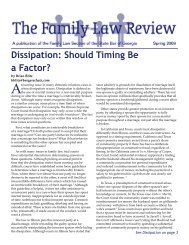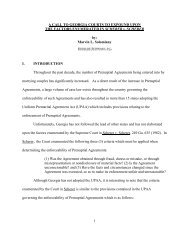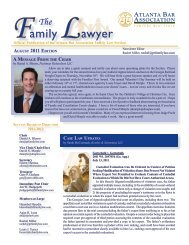Fall 2009 - Atlanta - Divorce Lawyer - Family Law - Atlanta Georgia
Fall 2009 - Atlanta - Divorce Lawyer - Family Law - Atlanta Georgia
Fall 2009 - Atlanta - Divorce Lawyer - Family Law - Atlanta Georgia
You also want an ePaper? Increase the reach of your titles
YUMPU automatically turns print PDFs into web optimized ePapers that Google loves.
Death: Many settlement agreements require lifeinsurance to replace child support and/or alimonypayments that would terminate at the death of the payor.While this is a great idea, there are wide variances in howthe life insurance is handled, providing widely variableresults for your client.In all cases, having the right amount of insurance isthe first step. Most financial advisors and accountantscan easily provide you with a so-called “net presentvalue” calculation to determine a reasonable amount ofinsurance to replace the income stream that would belost. Next, you will decide whether to use an existingpolicy, or if a new policy is needed to meet your client’sneeds. If the latter, ask the spouse to apply during thesettlement negotiations, not after. Underwriting can take6-12 weeks and you never know what medical issues canturn up. If the new policy turns out to be unavailable ormore expensive than planned, you want that informationbefore your client signs the final decree. Last, the ownerand beneficiary of the policy are critical. If the spousewill be the owner of the policy, naming your client asbeneficiary, be aware that your client will not receivenotification from the insurance company if he changesthe beneficiary, reduces the death benefit, or cancels thepolicy altogether. Your decree may provide her the rightto request periodic proof of coverage, but if he has diedor become uninsurable in the meantime, redress becomeschallenging. An added protection is to have your clientnamed as irrevocable beneficiary of the policy. This way,the insurance company will not process any request toremove your client as beneficiary. It does not, however,prevent the spouse/owner from canceling the policyintentionally, or through failure to pay the premiums. Themost secure option is for your client to be the owner ANDbeneficiary of the policy. As the owner, she retains control.Only she can change the beneficiary or make otherchanges to the policy. She will be notified if premiums arenot being paid and can make payments herself to keep thepolicy in force.Long-term Care: When someone begins to need helpcaring for themselves, the first line of defense is often thespouse 3 . Your client will soon be single and will thereforenot have a spouse available to provide this initial care;she may instead need to pay for in-home assistance. Ifher needs become too complex to care for at home, shewill need to turn to adult day care, assisted living ornursing homes. In fact, nearly three out of four nursinghome residents are women 4 . How will she pay for thisexpense? How will she find and select the caregivers? Agood long-term care policy can be the answer. For anyclient 50 or older, I urge you to make this part of thesettlement discussion. Using the family’s current agent,the employer’s HR department if they offer LTC, orsomeone you refer from your professional network, obtaininsurance quotes during the settlement process and reflectthe cost on the DRFA. Depending on the age and healthof your client, she could transfer much of her risk foranywhere from $2-$6,000/year.One great “trick of the trade” with long term careinsurance is that many insurers provide discounts of 20-40 percent if couples apply together. Some even allow thecouples discount to continue after a divorce. Therefore,collaborating to obtain coverage before while the coupleis still married can allow each party to obtain reducedpricing on this critical coverage. As with life insurance,underwriting can take 6-12 weeks, so encourage your client(and their spouse) to apply early in the process.Conclusion:No matter how well a family law practitioner representstheir client, it is ultimately the client’s responsibility tomake good decisions and properly manage their share ofthe settlement. By using the three steps outlined above,however, you can increase the impact you have on yourclient, giving them a greater chance to avoid becomingthe next “Jenny.” You can expand your reputation asan effective practitioner. And you can generate moreopportunities to send business to professionals in yourreferral network (or develop relationships with new ones),thereby increasing the odds of gaining referrals in return.Good for your client, good for your referral partners, goodfor you. Good practicing! FLREndnotes1) Jenny is an example, not meant to represent any specific client2) Assumptions include: inflation- 3.5 percent; gross rate ofreturn- 7.5 percent ; average tax rate- 25 percent3) Nearly 23 million Americans are providing unpaid care fora relative or friend. Speech by Josefina Carbonell, U.S.Assistant Secretary for Aging, on April 10,2003. RetrievedAug. 9, 2005, from the World Wide Web at www.aoa.gov/press/speeches/2003/04_apr/speeches_archive_04_14_pf.asp.4) Derived from Table 13, the Centers for Disease Control andPrevention, Vital and Health Statistics, June 2002, Retrievedfrom the World Wide Web Aug. 13,2005, at www.cdc.gov/nchs/data/series/sr_13/sr13_152.pdf.GVFA <strong>2009</strong> 0091DOFU 8/<strong>2009</strong>Suzanne Durbin is a partner with GVFinancial Advisors. She has been recognizedby the Five Star: Best in Client SatisfactionSM Wealth Manager Program in both2008 and <strong>2009</strong>. She and the other Advisorsat GV use the proprietary Guided WealthTransformation TM process to help their clientsuse their wealth to create the lives they desire,enhance the lives of the people they love, and create a legacy thatrepresents their passions and values. You can contact Suzanneat suzanne.durbin@gvfinancial.com, 770-295-5611, www.gvfinancial.com, or her profile on LinkedIn, www.linkedin.com/in/suzannedurbin.The <strong>Family</strong> <strong>Law</strong> Review 32<strong>Fall</strong> <strong>2009</strong>
















